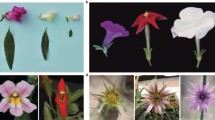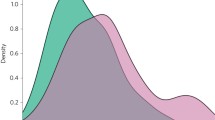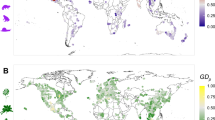Abstract
Evidence for rapid evolutionary change in plants in response to changing environmental conditions is widespread in the literature. However, evolutionary change in plant populations has not been quantified using a rate metric that allows for comparisons between and within studies. One objective of this paper is to estimate rates of evolution using data from previously published studies to begin a foundation for comparison and to examine trends and rates of microevolution in plants. We use data gathered from studies of plant adaptations in response to heavy metals, herbicide, pathogens, changes in pH, global change, and novel environments. Rates of evolution are estimated in the form of two metrics, darwins and haldanes. A second objective is to demonstrate how estimated rates could be used to address specific microevolutionary questions. For example, we examine how evolutionary rate changes with time, life history correlates of evolutionary rates, and whether some types of traits evolve faster than others. We also approach the question of how rates can be used to predict patterns of evolution under novel selection pressures using two contemporary examples: introductions of non-native species to alien environments and global change.
Access this chapter
Tax calculation will be finalised at checkout
Purchases are for personal use only
Preview
Unable to display preview. Download preview PDF.
Similar content being viewed by others
References
Abbott, R.J., 1992. Plant invasions interspecific hybridization and the evolution of new plant taxa. Trends Ecol. Evol. 7: 401–405.
Antonovics, J. & A.D. Bradshaw, 1970. Evolution in closely adjacent plant populations. VII Clinal patterns of a mine boundary. Heredity 25: 349–362.
Arnold, M.L., 1997. Natural Hybridization and Evolution. Oxford University Press, New York.
Barnes, J., J. Bender, T. Lyons & A. Borland. 1999. Natural and man-made selection for air pollution resistance. J. Exp. Bot. 50: 1423–1435.
Barrett, S.C.H., 1983. Crop mimicry in weeds. Econ. Bot. 37: 255–282.
Barrett, S.C.H., 2000. Microevolutionary influences of global changes on plant invasions, pp. 115–139 in Invasive Species in a Changing World, edited by H.A. Mooney & R.J. Hobbs. Island Press, Washington D.C.
Baur, B. & A. Erhardt, 1995. Habitat fragmentation and habitat alterations: principal threats to most animal and plant species. GAIA 4: 221–226.
Bazzaz, F.A., M. Jasieński, S.C. Thomas & P. Wayne, 1995. Microevolutionary responses in experimental populations of plants to CO2-enriched environments: parallel results from model systems. Proc. Natl. Acad. Sci. USA 92: 8161–8165.
Bell, J.N.B., M.R. Ashmore & G.B. Wilson, 1991. Ecological genetics and chemical modifications of the atmosphere, pp. 33–59 in Ecological Genetics and Air Pollution, edited by G.E. Taylor, L.F. Pitelka & M.T. Clegg. Springer-Verlag, New York, Berlin, London, Tokyo.
Blossey, B. & R. Nötzold, 1995. Evolution of increased competitive ability in invasive nonindigenous plants: a hypothesis. J. Ecol. 83: 887–889.
Bradshaw, A.D. & T. McNeilly, 1991a. Evolution in relation to environmental stress, pp. 11–32 in Ecological Genetics and Air Pollution, edited by G.E. Taylor, L.F. Pitelka & M.T. Clegg. Springer-Verlag, Berlin.
Bradshaw, A.D. & T. McNeilly, 1991b. Evolutionary response to global climate change. Ann. Bot. 67: 5–14.
Burdon, J.J. & J.N. Thompson, 1995. Changed patterns of resistance in a population of Linum marginale attacked by the rust pathogen Melampsora lini. J. Ecol. 83: 199–206.
Burger, R. & M. Lynch, 1995. Evolution and extinction in a changing environment: a quantitative-genetic analysis. Evolution 49: 151–163.
Carney, S.E., K.A. Gardner & L.H. Rieseberg, 2000. Evolutionary changes over the fifty-year history of a hybrid population of sunflowers (Helianthus). Evolution 54: 462–474.
Carroll, S.P., H. Dingle, T.R. Famula & C.W. Fox, 2001. Genetic architecture of adaptive differentiation in evolving host races of the Soapberry Bug, Jadera haematoloma. Genetica 112-113: 257–272.
Cody, M.L. & J.M. Overton, 1996. Short-term evolution of reduced dispersal in island plant populations. J. Ecol. 84: 53–61.
Crooks, J. & M.E. Soule, 1996. Lag times in population explosions of invasive species: causes and implications, pp. 39–46 in Proceedings of the Norway/UN Conference on Alien Species, edited by O.T. Sanlund, P.T. Schei, & Å. Viken. Directorate for Nature Management and Norwegian Institute for Nature Research, Trondheim, Norway.
Curtis, P.S., D.J. Klus, S. Kalisz & S.J. Tonser, 1996. Intraspe-cific variation in CO2 responses in Raphanus raphanistrum and Pkmtago lanceolata: Assessing the potential for evolutionary change with rising atmospheric CO2, pp. 13–22 in Carbon Dioxide, Populations, and Communities, edited by C. Körner & F.A. Bazzaz. Academic Press, San Diego.
Daehler, C.C. & D.R. Strong, 1997. Reduced herbivore resistance in introduced smooth cordgrass (Spartina alterniflora) after a century of herbivore-free growth. Oecologia 110: 99–108.
Davies, M.S. & R.W. Snaydon, 1976. Rapid population differentiation in a mosaic environment. III. Measures of selection pressures. Heredity 36: 59–66.
Davis, M.B. & R.G. Shaw. 2001. Range shifts and adaptive responses to quaternary climate change. Science 292: 673–679.
Davison, A.W. & J.D. Barnes. 1998. Effects of ozone on wild plants. New Phytol. 139: 135–151.
Davison, A.W. & K. Reiling, 1995. A rapid change in ozone resistance of Pkmtago major after summers with high ozone concentrations. New Phytol. 131: 337–344.
Debinski, D.M. & R.D. Holt, 2000. A survey and overview of habitat fragmentation experiments. Conserv. Biol. 14: 342–355.
Dudley, J.W., 1977. Seventy-six generations of selection for oil and protein percentage in maize, pp. 459–473 in Proceedings of the International Conference on Quantitative Genetics, edited by E. Pollak, O. Kempthorne & T.B. Bailey. Iowa State University, Ames, IA.
Dudley, J.W. & R.J. Lambert. 1992. Ninety generations of selection for oil and protein in maize. Maydica 37: 1–7.
Ernst, W.H.O., 1999. Evolution of plants on soils anthropogenic-ally contaminated by heavy metals, pp. 13–27 in Plant Evolution in Man-made Habitats, edited by L.W.D. van Raamsdonk & J.C.M. den Nijs. Hugo de Vries Laboratory, Amsterdam, The Netherlands.
Erskine, W., J. Smartt & F. Muehlbauer, 1994. Mimicry of lentil and the domestication of common vetch and grass pea. Econ. Bot. 48: 326–332.
Frey, K.J. & J.B. Holland, 1999. Nine cycles of recurrent selection for increased groat-oil content in oat. Crop Sci. 39: 1636–1641.
Gilchrist, G.W., R.B. Huey & L. Serra. 2001. Rapid evolution of wing size clines in Drosophila subobscura. Genetica 112-113: 273–286.
Gingerich, P.D.. 1983. Rates of evolution: effects of time and temporal scaling. Science 222: 159–161.
Goodwin, B.J., A.J. McAllister & L. Fahrig, 1999. Predicting invasiveness of plant species based on biological information. Conserv. Biol. 13:422–426.
Grant, P.R. & B.R. Grant, 1995. Predicting microevolutionary responses to directional selection on heritable variation. Evolution 49:241–251.
Haidane, J.B.S., 1949. Suggestions as to quantitative measurement of rates of evolution. Evolution 3: 51–56.
Haugen, T.O. & L.A. Vøllestad, 2001. A century of life-history evolution in grayling. Genetica 112-113: 475–491.
Heap, I.M., 1997. The occurrence of herbicide-resistant weeds worldwide. Pest. Sci. 51: 235–243.
Hendry, A.P. & M.T. Kinnison, 1999. The pace of modern life: measuring rates of microevolution. Evolution 53: 1637–1653.
Houle, D., 1992. Comparing evolvability and variability of quantitative traits. Genetics 130: 195–204.
Huey, R.B., G.W. Gilchrist, M.L. Carlson, D. Berrigan & L. Serra, 2000. Rapid evolution of a geographic cline in size in an introduced fly. Science 287: 308–309.
Jain, S.K. & A.D. Bradshaw, 1966. Evolutionary divergence among adjacent plant populations. I: evidence and its theoretical analysis. Heredity 21: 407–441.
Kiang, Y.T., 1982. Local differentiation of Anthoxanthum odoratum L. populations on roadsides. Am. Midland Natural. 107: 340–350.
Kingsolver, J.G., H.E. Hoekstra, J.M. Hoekstra, D. Berrigan, S.N. Vignieri, C.E. Hill, A. Hoang, P. Gilbert & P. Beerli, 2001. The strength of phenotypic selection in natural populations. Am. Natural. 157: 245–261.
Kinnison, M.T. & A.P. Hendry, 2001. The pace of modern life. II: from rates to pattern and process. Genetica 112-113: 145–164.
Kowarik, I., 1995. Time lags in biological invasions with regard to the success and failure of invasive species, pp. 15–38 in Plant Invasions: General Aspects and Special Problems, edited by P. Pysek, K. Prach, M. Rejmánek & M. Wade. SPB Academic Publishing, Amsterdam, The Netherlands.
Lambert, R.J., D.E. Alexander, E.L. Mollring & B. Wiggens, 1997. Selection for increased oil concentration in maize kernels and associated changes in several kernel plants. Maydica 42: 39–43.
Linhart, Y.B. & M.C. Grant, 1996. Evolutionary significance of local genetic differentiation in plants. Ann. Rev. Ecol. Systemat. 27: 237–277.
Lynch, M., 1990. The rate of morphological evolution in mammals from the standpoint of the neutral expectation. Am. Natural. 136: 727–741.
Mack, R.N., 1996. Predicting the identity and fate of plant invaders: emergent and emerging approaches. Biol. Conserv. 78: 107–121.
Macnair, M.R., S.E. Smith & Q.J. Cumbes, 1993. Heritability and distribution of variation in degree of copper tolerance in Mimulus guttatus at Copperopolis, California. Heredity 71: 445–455.
Mallory-Smith, C., P. Hendrickson & G. Mueller-Warrant, 1999. Cross-resistance of primisulfuron-resistant Bromus tectorum L. (downy brome) to sulfosulfuron. Weed Sci. 47: 256–257.
Menlä, J., B.C. Sheldon & L.E.B. Kruuk. 2001. Explaining stasis: microevolutionary studies in natural populations. Genetica 112-113: 199–222.
Mousseau, T.A. & D.A. Roff, 1987. Natural selection and the heritability of fitness components. Heredity 59: 181–197.
Neuffer, B. & M. Linde, 1999. Capsella bursa-pastoris-colonization and adaptation; a globe trotter conquers the world, pp. 49–72 in Plant Evolution in Man-made Habitats, edited by L.W.D. van Raamsdonk & J.C.M. den Nijs. Hugo de Vries Laboratory, Amsterdam, The Netherlands.
Nordal, I., K.B. Haraldsen, A. Ergon & A.B. Eriksen, 1999. Copper resistance and genetic diversity in Lychnis alpina (Ca-ryophyllaceae) populations on mining sites. Folia Geobot. 34: 471–481.
Powles, S.B., D.F. Lorraine-Colwill, J.J. Dellow & C. Preston, 1998. Evolved resistance to glyphosate in rigid ryegrass (Lolium rigidum) in Australia. Weed Sci. 46: 604–607.
Pyšek, P., 1998. Alien and native species in Central European urban floras: a quantitative comparison. J. Biogeography 25: 155–163.
Rejmánek, M., 2000. Invasive plants: approaches and predictions. Austral Ecol. 25: 497–506.
Reznick, D.N. & C.K. Ghalambor, 2001. The population ecology of contemporary adaptations: what empirical studies reveal about the conditions that promote adaptive evolution. Genetica 112-113: 183–198.
Reznick, D.N., F.H. Shaw, F.H. Rodd & R.G. Shaw, 1997. Evaluation of the rate of evolution in natural populations of guppies (Poecilia reticulata). Science 275: 1934–1937.
Sauer, J.D., 1988. Plant Migration: The Dynamics of Geographic Patterning in Seed Plant Species. University of California Press, Berkeley.
Shaw, J., J. Antonovics & L.E. Anderson, 1987. Inter-and intra specific variation of mosses in tolerance to copper and zinc. Evolution 41: 1312–1325.
Schluter, D., 2000. The Ecology of Adaptive Radiation. Oxford University Press, Oxford.
Snaydon, R.W., 1970. Rapid population differentiation in a mosaic environment. I: the response of Anthoxanthum odoratum to soils. Evolution 24: 257–269.
Smith, S.D., T.E. Huxman, S.F. Zitzer, T.N. Charlet, D.C. Housman, J.S. Coleman, L.K. Fenstermaker, J.R. Seemann & R.S. Nowak, 2000. Elevated CO2 increases productivity and invasive species success in an arid ecosystem. Nature 408: 79–82.
Snaydon, R.W. & M.S. Davies, 1972. Rapid population differentiation in a mosaic environment. II: morphological variation in Anthoxanthum odoratum. Evolution 26: 390–405.
Snaydon, R.W. & M.W. Davies, 1982. Rapid divergence of plant populations in response to recent changes in soil conditions. Evolution 36: 289–297.
Stearns, S.C., 1992. The Evolution of Life Histories. Oxford University Press, Oxford, UK.
Thomas, S.C. & M. Jasieński, 1996. Genetic variability and the nature of microevolutionary responses to elevated CO2, pp. 51–81 in Carbon Dioxide, Populations, and Communities, edited by C. Körner & F.A. Bazzaz. Academic Press, San Diego, CA.
Ward, J.K., J. Antonovics, R.B. Thomas & B.R. Strain, 2000. Is atmospheric CO2 a selective agent on model C3 annuals? Oecologia 123: 330–341.
Warwick, S.I. & E. Small, 1999. Invasive plant species: evolutionary risk from transgenic crops, pp. 235–256 in Plant Evolution in Man-made Habitats, edited by L.W.D. van Raamsdonk & J.C.M. den Nijs. Hugo de Vries Laboratory, Amsterdam, The Netherlands.
Whitfield, C.P., A.W. Davison & T.W. Ashenden, 1997. Artificial selection and heritability of ozone resistance in two populations of Plantago major. New Phytol. 137: 645–655.
Williamson, M. & A. Fitter, 1996. The varying success of invaders. Ecology 77: 1666–1670.
Willis, A.J., J. Memmott & R.I. Forrester, 2000. Is there evidence for the post-invasion evolution of increased size among invasive plant species? Ecol. Lett. 3: 275–283.
Wu, L. & J. Antonovics, 1976. Experimental genetics of Plantago. II: lead tolerance in P. lanceolata and Cynodon dactylon from a roadside. Ecology 37: 205–208.
Wu, L., A.D. Bradshaw & D.A. Thurman, 1975. The potential for evolution of heavy metal tolerance in plants. III: the rapid evolution of copper tolerance in Agrostis stolonifera. Heredity 34: 165–187.
Wu, L. & A.L. Kruckeberg, 1985. Copper tolerance in two legume species from a copper mine habitat. New Phytol. 99: 565–570.
Author information
Authors and Affiliations
Editor information
Rights and permissions
Copyright information
© 2001 Springer Science+Business Media Dordrecht
About this chapter
Cite this chapter
Bone, E., Farres, A. (2001). Trends and rates of microevolution in plants. In: Hendry, A.P., Kinnison, M.T. (eds) Microevolution Rate, Pattern, Process. Contemporary Issues in Genetics and Evolution, vol 8. Springer, Dordrecht. https://doi.org/10.1007/978-94-010-0585-2_11
Download citation
DOI: https://doi.org/10.1007/978-94-010-0585-2_11
Publisher Name: Springer, Dordrecht
Print ISBN: 978-94-010-3889-8
Online ISBN: 978-94-010-0585-2
eBook Packages: Springer Book Archive




